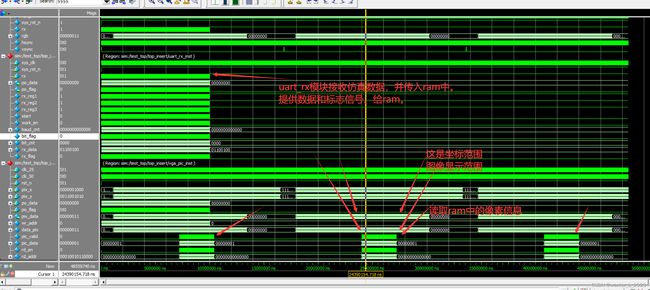FPGA project : uart232_ram_vga
重点学习:
本实验重点学习了双口ram解决多bit跨时钟域同步处理的问题。
其实signal port ram,它的输入口和输出口分别用不同的时钟,也可以解决这个问题。
让我意识到的比较重要的事情:
1,代码设计中,一些大于10的数字,尽量用parameter设定一些可以重传的参数来代替。因为这样方便仿真修改。我就是之前写uart_rx模块,数字啥的没用参数替代。这个实验中仿真时需要修改参数,然后重新修改了uart_rx代码。使得仿真时间大大缩短,很方便。
2,在vga_pic模块中模拟产生的ram,读完数据后,ram里面的数据并没有消失,还在。
写数据:在时钟上升沿,写使能拉高,与此同时要有对应的地址与数据。然后数据就写进对应的地址里面了。
读数据:在时钟上升沿,读使能拉高,与此同时给出地址,然后数据就都出来了。值得一提的是,数据会滞后一个时钟周期(相对于读使能与地址),说明ram内部用的时序逻辑嘛。
3, task input ...如果写在task内部了。那么在task name 后面就不要加括号了。否则modulism会报错。
module vga_pic (
input wire clk_25 , // ram 的输出时钟,也是vga图像的时钟。
input wire clk_50 , // ram 的输入时钟
input wire rst_n , // 经过系统复位和pll的locked相与后的复位。
input wire [9:0] pix_x ,
input wire [9:0] pix_y ,
input wire [7:0] po_data , // 写入的数据的数据
input wire po_flag , // 用作ram的读使能。
output wire [7:0] pix_data
);
// parameter
parameter H_VALID = 10'd640 ,
V_VALID = 10'd480 ;
parameter PIC_SIZE= 14'd1_0000 ,
H_PIC = 10'd100 ,
V_PIC = 10'd100 ;
parameter RED = 8'b1110_0000 ,
GREEN = 8'b0001_1100 ,
BLUE = 8'b0000_0011 ,
WHITE = 8'b1111_1111 ,
BLACK = 8'b0000_0000 ;
// reg signal define
reg [13:0] wr_addr ; // ram 的写地址。
reg [ 7:0] data_pix ; // 彩条像素
reg pic_valid; // 图片有效
wire [ 7:0] pic_data ; // 图片像素
reg rd_en ; // ram读使能
reg [13:0] rd_addr ;
/************************************************************************/
// reg [13:0] wr_addr ; // ram 的写地址。
always @(posedge clk_50 or negedge rst_n) begin
if(~rst_n) begin
wr_addr <= 14'd0 ;
end else begin
if(po_flag) begin
if(wr_addr == 9999) begin // 记到最大的地址后归零。
wr_addr <= 14'd0 ;
end else begin
wr_addr <= wr_addr + 1'b1 ;
end
end else begin
wr_addr <= wr_addr ;
end
end
end
// reg [ 7:0] data_pix ; // 彩条像素
always @(posedge clk_25 or negedge rst_n) begin
if(~rst_n) begin
data_pix <= BLACK ;
end else begin
if(pix_y >= 0 && pix_y <= (V_VALID / 5 - 1))
data_pix <= RED ;
else if((pix_y >= V_VALID / 5) && pix_y <= ((V_VALID / 5 ) * 2) - 1)
data_pix <= GREEN ;
else if((pix_y >= (V_VALID / 5) * 2) && pix_y <= ((V_VALID / 5 ) * 3) - 1)
data_pix <= BLUE ;
else if((pix_y >= (V_VALID / 5) * 3) && pix_y <= ((V_VALID / 5 ) * 4) - 1)
data_pix <= WHITE ;
else if((pix_y >= (V_VALID / 5) * 4) && pix_y <= (V_VALID - 1))
data_pix <= BLACK ;
else
data_pix <= BLACK ;
end // 先不写else 一会看编译是否会通过。
end
// reg pic_valid; // 图片有效
always @(posedge clk_25 or negedge rst_n) begin
if(~rst_n) begin
pic_valid <= 1'b0 ;
end else begin
if(pix_x >= 269 && pix_x <= 368 && pix_y >= 190 && pix_y <= 289) begin
pic_valid <= 1'b1 ;
end else begin
pic_valid <= 1'b0 ;
end
end
end
// wire [ 7:0] pic_data ; // 图片像素
// 图片像素存在了ram中,所以只需要取出来就是图片像素了。
// reg rd_en ; // ram读使能
always @(posedge clk_25 or negedge rst_n) begin
if(~rst_n) begin
rd_en <= 1'b0 ;
end else begin
if(pix_x >= 268 && pix_x <= 367 && pix_y >= 190 && pix_y <= 289) begin
rd_en <= 1'b1 ;
end else begin
rd_en <= 1'b0 ;
end
end
end
// reg [13:0] rd_addr ;
always @(posedge clk_25 or negedge rst_n) begin
if(~rst_n) begin
rd_addr <= 14'd0 ;
end else begin
if(rd_en) begin
if(rd_addr == 9999) begin
rd_addr <= 14'd0 ;
end else begin
rd_addr <= rd_addr + 1'b1 ;
end
end else begin
rd_addr <= rd_addr ;
end
end
end
/**********************output signal define**************************************/
// wire [7:0] pix_data ;
assign pix_data = (pic_valid == 1'b1) ? pic_data : data_pix ;
/******************例化双口ram*******************/
ram_10000_double ram_10000_double_insert(
.data ( po_data ) ,
.inclock ( clk_50 ) ,
.outclock ( clk_25 ) ,
.rdaddress ( rd_addr ) ,
.wraddress ( wr_addr ) ,
.wren ( po_flag ) ,
.q ( pic_data)
);
endmodule
module top(
input wire sys_clk ,
input wire sys_rst_n ,
input wire rx ,
output wire [7:0] rgb ,
output wire hsync ,
output wire vsync
);
// 例化间连线
wire rst_n ;
wire [7:0] po_data ;
wire po_flag ;
wire [7:0] pix_data ;
wire [9:0] pix_x ;
wire [9:0] pix_y ;
wire clk_25 ;
wire clk_50 ;
pll pll_inst (
.sys_rst_n ( sys_rst_n ) ,
.areset ( ~sys_rst_n ) ,
.inclk0 ( sys_clk ) ,
.c0 ( clk_25 ) ,
.c1 ( clk_50 ) ,
.locked ( rst_n )
);
uart_rx uart_rx_inst(
.sys_clk ( clk_50 ) ,
.sys_rst_n ( rst_n ) ,
.rx ( rx ) ,
.po_data ( po_data ) ,
.po_flag ( po_flag )
);
vga_ctrl vga_ctrl_inst(
.vga_clk ( clk_25 ) ,
.vga_rst_n ( rst_n ) ,
.pix_data ( pix_data ) ,
.hsync ( hsync ) ,
.vsync ( vsync ) ,
.pix_x ( pix_x ) ,
.pix_y ( pix_y ) ,
.rgb ( rgb )
);
vga_pic vga_pic_inst(
.clk_25 ( clk_25 ) ,
.clk_50 ( clk_50 ) ,
.rst_n ( rst_n ) ,
.pix_x ( pix_x ) ,
.pix_y ( pix_y ) ,
.po_data ( po_data ) ,
.po_flag ( po_flag ) ,
.pix_data ( pix_data )
);
endmodule`timescale 1ns/1ns
module test_top();
reg sys_clk ;
reg sys_rst_n ;
reg rx ;
wire [7:0] rgb ;
wire hsync ;
wire vsync ;
reg [7:0] data_mem [9999:0];
top top_insert(
.sys_clk ( sys_clk ) ,
.sys_rst_n ( sys_rst_n ) ,
.rx ( rx ) ,
.rgb ( rgb ) ,
.hsync ( hsync ) ,
.vsync ( vsync )
);
defparam top_insert.uart_rx_inst.CLK_FREQ = 5 ;
defparam top_insert.uart_rx_inst.UART_BPS = 1 ;
parameter CYCLE = 20 ;
initial begin
sys_clk = 1'b1 ;
sys_rst_n <=1'b0 ;
#(CYCLE) ;
sys_rst_n <=1'b1 ;
end
always #(CYCLE / 2) sys_clk = ~sys_clk ;
initial begin
$readmemh ("D:/intel_FPGA/VScodedocument/EmbedFire/31 rs232_vga/matlab/data_test.txt",data_mem);
end
initial begin
rx <= 1'b1 ;
#(CYCLE * 10) ;
rx_byte ;
end
task rx_byte;
integer j ; // j 是存储器的地址。
for (j = 0;j < 10000 ;j = j + 1 ) begin
rx_bit(data_mem[j]) ; // 没有输入端口,自然不需要输入参数。
end
endtask
task rx_bit;
input [7:0]data ;
integer i ;
for (i = 0;i < 10 ;i = i + 1 ) begin
case (i)
0:rx <= 1'b0;
1:rx <= data[0];
2:rx <= data[1];
3:rx <= data[2];
4:rx <= data[3];
5:rx <= data[4];
6:rx <= data[5];
7:rx <= data[6];
8:rx <= data[7];
9:rx <= 1'b1;
default: rx <= 1'b1;
endcase
#(5 * CYCLE) ;
end
endtask
endmodule



